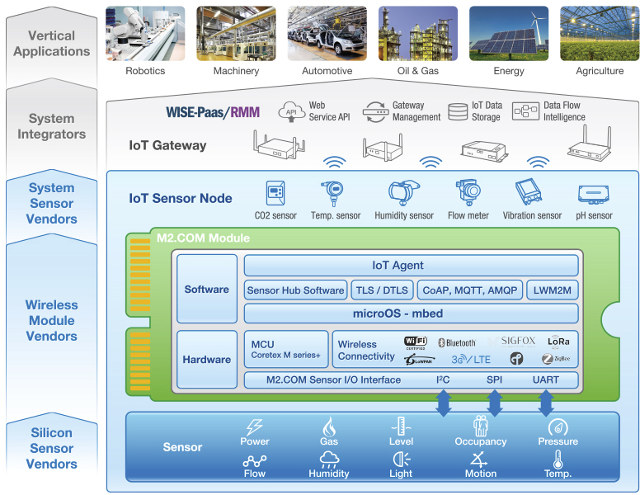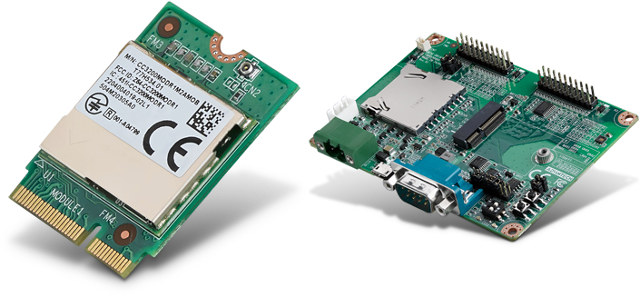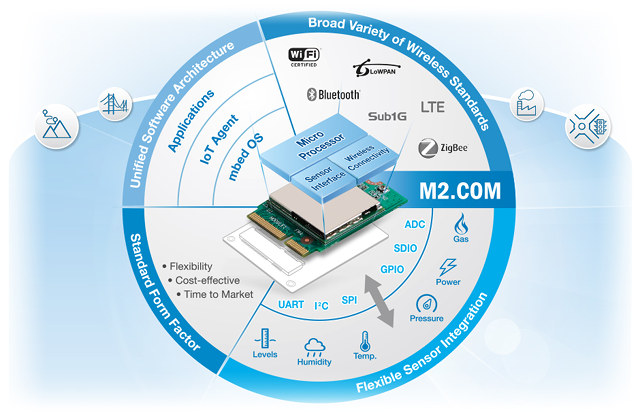The IoT ecosystem really feels like a jungle now, not because of a lack of standards, but because everybody thinks about doing their own, so we’ve ended up with a wide range of communication protocols, initiatives, and consortia, and it will take some time until the winners and losers are sorted out. One the of the latest standard is M2.COM platform form factor for sensors that “adopts the standardized M.2 form factor and is defined as an evolutionary module that combines general wireless connectivity with additional built-in computing ability powered by MCU”.
 M2.COM architecture diagram above describes both software and hardware requirements, but the specifications themselves only define the form factor, as well as mechanical and electrical characteristics:
M2.COM architecture diagram above describes both software and hardware requirements, but the specifications themselves only define the form factor, as well as mechanical and electrical characteristics:
- Consistent with M.2 standard
- Module size: 22 mm x 30 mm
- PCB thickness: 0.8 mm ± 10%
- Pin count: 75 pins
- Module input voltage: 3.3V DC-in
- Connector mating force: 30N Maximum
- Connector current rating: 0.5A / Power contact
- Connector operation temperature range: -45°C to +85°C
- Suitable pin definitions for IoT solution
- USB – A common interface for extending storage
- SDIO – Another common interface for extending storage through SD/MMC
- I2C – The most popular interface for sensors. Ex: pressure sensor, temperature sensor, moisture sensor and lightning sensor
- I2S – Supports audio codec for broadcasting and playing audio through external speakers
- UART – A commonly used protocol for device control, such as for motor and electric control units
- GPIO – Basic I/O control, such as indicating lights, alarm and buzzer
- SPI – Supports LCM to display values collected from the sensor or transmitted by an external device
- ADC – Common pins of GPIO, the ADC transforms the analog signal from the sensor into a digital signal so that data can be readable and meaningful to the data analyzer
So the idea is basically to be able to exchange one M2.COM compliant module with another one with better features or a lower cost as needed. You can download the specifications 1.0, design guide, and mechanical information on M2.COM website.
Companies behind the initiative include ARM, Advantech, Bosch, Texas Instruments, and Sensirion. Two products compliant with the standard are currently available: Advantech WISE-1520 M2.COM module and the corresponding WISE-DB1500 carrier board / development board using pico-ITX form factor (100 x 72 mm).

WISE-1520 M2.COM module specifications:
- SoC – Texas Instruments CC3200MOD Cortex-M4 MCU with 256KB RAM, 1MB flash
- Connectivity – 802.11 b/g/n @ 2.4 GHz up to 16Mbps (UDP)
- I/O interfaces – 1x 4-wire UART, 1x I2C, 2 GPIOs, 2x PWM, 1x SPI, 2x ADC as per the specs (but no USB)
- Debug Port – 1x developer and debug port.
- Power – 3.3V
- Dimensions – 30 x 22 mm – M.2 type 2230-D3-E form factor
- Weight – 3 grams
The module runs TI RTOS or ARM mbed OS, and supports multiple IoT communication protocols including LWM2M, OSGI, AllJoyn and MQTT. Software documentation and SDK do not appear to be available publicly.
The development board features a M.2 socket and brings out an SD card slots, expansion headers, a RS-232/422/485 DB9 connector, and a micro USB OTG port, as well as an on-board humidity & temperature sensor.
You can find out more about Advantech solution on M2.COM product page.
Via Embedded.com

Jean-Luc started CNX Software in 2010 as a part-time endeavor, before quitting his job as a software engineering manager, and starting to write daily news, and reviews full time later in 2011.
Support CNX Software! Donate via cryptocurrencies, become a Patron on Patreon, or purchase goods on Amazon or Aliexpress




